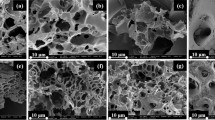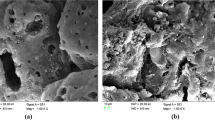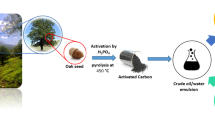Abstract
This study presents 5-hydroxymethylfurfural removal from waste hand paper hydrolysate using activated carbon adsorption. In this context, the effects of adsorbent dosage, initial 5-hydroxymethylfurfural concentration, temperature, and agitation speed on 5-hydroxymethylfurfural adsorption were investigated. Moreover, isotherm and kinetic evaluations were performed using Langmuir, Freundlich, and Temkin models. The experimental data were correlated with zero, first, pseudo-first, and Weber–Morris intraparticle diffusion models. The toxicity of 5-hydroxymethylfurfural was determined using the resazurin reduction assay, and the EC50 of 5-hydroxymethylfurfural in the hydrolysate was found as 192 mg/L. Most convenient 5-hydroxymethylfurfural adsorption was obtained at 5 g/L AC dosage, 40 °C and 150 rpm agitation speed. The highest 5-hydroxymethylfurfural removal efficiency was 92% at 7 g/L AC dosage. The adsorption data fitted best with the Langmuir isotherm model with a maximum uptake capacity of 70.92 mg/g (R2: 0.96). The zero-order reaction kinetic model was the most suitable one among the others inspected. It was determined that intraparticle diffusion was not the rate-limiting step. This study showed that waste hand paper hydrolysate can effectively be detoxified by activated carbon adsorption.






Similar content being viewed by others
References
Agbor VB, Cicek N, Sparling R et al (2011) Biomass pretreatment: fundamentals toward application. Biotechnol Adv 29:675–685
Argun H, Onaran G (2016) Hydrogen gas production from waste paper by sequential dark fermentation and electrohydrolysis. Int J Hydrogen Energy 41:8057–8066
Argun H, Onaran G (2018) Dark fermentative hydrogen gas production from lime treated waste paper towel hydrolysate. Waste Biomass Valoriz 9:801–810
Argun H, Pelin G, Kapdan IK (2017) Biohydrogen production potential of different biomass sources. In: Singh A, Rathore D (eds) Biohydrogen production: sustainability of current technology and future perspective. Springer India, New Delhi, pp 11–48
Ava-biochem.com (2014) http://www.ava-biochem.com/media/downloads_EN/safety_data_sheet/5-%28Hydroxymethyl%29-furfural_AVA_Biochem_US_Rev_1.00_121201.pdf. Accessed 1 Feb 2019
Balan V (2014) Current challenges in commercially producing biofuels from lignocellulosic biomass. ISRN Biotechnol 2014:1–31
Bedia J, Belver C, Ponce S et al (2018) Adsorption of antipyrine by activated carbons from FeCl3-activation of Tara gum. Chem Eng J 333:58–65
Brouwer H (1991) Testing for chemical toxicity using bacteria. J Chem Educ 68:695–697
Chaturvedi V, Verma P (2013) An overview of key pretreatment processes employed for bioconversion of lignocellulosic biomass into biofuels and value added products. 3 Biotech 3:415–431
Chen R, Wang YZ, Liao Q et al (2013) Hydrolysates of lignocellulosic materials for biohydrogen production. BMB Rep 46:244–251
Chu H, Chen K (2002) Reuse of activated sludge biomass: I. Removal of basic dyes from wastewater by biomass. Process Biochem 37:595–600
Chu CY, Wu SY, Tsai CY, Lin CY (2011) Kinetics of cotton cellulose hydrolysis using concentrated acid and fermentative hydrogen production from hydrolysate. Int J Hydrogen Energy 36:8743–8750
Daneshvar E, Kousha M, Jokar M et al (2012a) Acidic dye biosorption onto marine brown macroalgae: isotherms, kinetic and thermodynamic studies. Chem Eng J 204–205:225–234
Daneshvar E, Kousha M, Sohrabi MS et al (2012b) Biosorption of three acid dyes by the brown macroalga Stoechospermum marginatum: isotherm, kinetic and thermodynamic studies. Chem Eng J 195–196:297–306
De Bhowmick G, Sarmah AK, Sen R (2018) Lignocellulosic biorefinery as a model for sustainable development of biofuels and value added products. Bioresour Technol 247:1144–1154
Delgado N, Capparelli A, Navarro A, Marino D (2019) Pharmaceutical emerging pollutants removal from water using powdered activated carbon: study of kinetics and adsorption equilibrium. J Environ Manag 236:301–308
Dutta S, Pal S (2014) Promises in direct conversion of cellulose and lignocellulosic biomass to chemicals and fuels: combined solvent-nanocatalysis approach for biorefinary. Biomass Bioenergy 62:182–197
Fan T, Liu Y, Feng B et al (2008) Biosorption of cadmium(II), zinc(II) and lead(II) by Penicillium simplicissimum: isotherms, kinetics and thermodynamics. J Hazard Mater 160:655–661
Freundlich H (1906) Over the adsorption in solution. J Phys Chem 57:385–470
Fu H, Li X, Wang J et al (2017) Activated carbon adsorption of quinolone antibiotics in water: performance, mechanism, and modeling. J Environ Sci 56:145–152
Geetha P, Latha MS, Koshy M (2015) Biosorption of malachite green dye from aqueous solution by calcium alginate nanoparticles: equilibrium study. J Mol Liq 212:723–730
Gonzales RR, Hong Y, Park JH et al (2016) Kinetics and equilibria of 5-hydroxymethylfurfural (5-HMF) sequestration from algal hydrolyzate using granular activated carbon. J Chem Technol Biotechnol 91:1157–1163
Hall KR, Eagleton LC, Acrivos A, Vermeulen T (1966) Pore and solid diffusion kinetics in fixed-bed adsorption under constant-pattern conditions. Ind Eng Chem Fundam 5:212–223
Harmsen P, Huijgen W, López L, Bakker R (2010) Literature review of physical and chemical pretreatment processes for lignocellulosic biomass. Wageningen UR Food & Biobased Research, Wageningen
Harrache Z, Abbas M, Aksil T, Trari M (2019) Thermodynamic and kinetics studies on adsorption of Indigo Carmine from aqueous solution by activated carbon. Microchem J 144:180–189
Heinonen J, Tamminen A, Uusitalo J, Sainio T (2012) Ethanol production from wood via concentrated acid hydrolysis, chromatographic separation, and fermentation. J Chem Technol Biotechnol 87:689–696
Hessami MJ, Phang SM, Salleh A, Rabiei R (2018) Evaluation of tropical seaweeds as feedstock for bioethanol production. Int J Environ Sci Technol 15:977–992
Huang YB, Fu Y (2013) Hydrolysis of cellulose to glucose by solid acid catalysts. Green Chem 15:1095–1111
Huang Q, Zhang H, Xiong L et al (2018) Controllable synthesis of monoacrylate-modified adsorption resins and enhancing adsorption toward fermentation inhibitors from rice straw hydrolysate. J Chem Technol Biotechnol 93:2652–2658
Jeihanipour A, Karimi K, Taherzadeh M (2014) Acid hydrolysis of cellulose-based waste textiles. In: The 7th international chemical engineering congress and exhibition IChEC. Kish, Iran, pp 21–24
Jin H, Li Y, Liu X et al (2015) Recovery of HMF from aqueous solution by zeolitic imidazolate frameworks. Chem Eng Sci 124:170–178
Kang S, Fu J, Zhang G (2018) From lignocellulosic biomass to levulinic acid: a review on acid-catalyzed hydrolysis. Renew Sustain Energy Rev 94:340–362
Keijsers ERP, Yilmaz G, Van Dam JEG (2013) The cellulose resource matrix. Carbohydr Polym 93:9–21
Khambhaty Y, Mody K, Basha S, Jha B (2009) Kinetics, equilibrium and thermodynamic studies on biosorption of hexavalent chromium by dead fungal biomass of marine Aspergillus niger. Chem Eng J 145:489–495
Kong Q, He X, Shu L, Miao M (2017) Ofloxacin adsorption by activated carbon derived from luffa sponge: kinetic, isotherm, and thermodynamic analyses. Process Saf Environ Prot 112:254–264
Kumar AK, Sharma S (2017) Recent updates on different methods of pretreatment of lignocellulosic feedstocks: a review. Bioresour Bioprocess 4:7
Lagergren S (1898) About the theory of so-called adsorption of soluble substances. K Sven Vetenskapsakad Handl 24:1–39
Langmuir I (1916) The Constitution and fundamental properties of solids and liquids. Part I. Solids. J Am Chem Soc 38:2221–2295
Liu D (1983) Resazurin reduction method for activated sludge process control. Environ Sci Technol 17:407–411
Ma H (2017) Adsorption removal of inhibiting compounds by modified activated carbon. J Energy Nat Resour 6:24
Melati RB, Shimizu FL, Oliveira GR et al (2018) Key factors affecting the recalcitrance and conversion process of biomass. BioEnergy Res 12:1–20. https://doi.org/10.1007/s12155-018-9941-0
Michael D, Gilles K, Hamilton J et al (1956) Colorimetric method for determination of sugars and related substances. Anal Chem 28:350–356
Mosier N, Wyman C, Dale B et al (2005) Features of promising technologies for pretreatment of lignocellulosic biomass. Bioresour Technol 96:673–686
Oguntimein GB (2015) Biosorption of dye from textile wastewater effluent onto alkali treated dried sunflower seed hull and design of a batch adsorber. J Environ Chem Eng 3:2647–2661
Orozco RL, Redwood MD, Leeke GA et al (2012) Hydrothermal hydrolysis of starch with CO2 and detoxification of the hydrolysates with activated carbon for bio-hydrogen fermentation. Int J Hydrogen Energy 37:6545–6553
Pérez J, Muñoz-Dorado J, De La Rubia T, Martínez J (2002) Biodegradation and biological treatments of cellulose, hemicellulose and lignin: an overview. Int Microbiol 5:53–63
Qu W, Yuan T, Yin G et al (2019) Effect of properties of activated carbon on malachite green adsorption. Fuel 249:45–53
Rangabhashiyam S, Anu N, Giri Nandagopal MS, Selvaraju N (2014) Relevance of isotherm models in biosorption of pollutants by agricultural byproducts. J Environ Chem Eng 2:398–414
Rattanapan S, Srikram J, Kongsune P (2017) Adsorption of methyl orange on coffee grounds activated carbon. Energy Procedia 138:949–954
Rosatella AA, Simeonov SP, Frade RFM, Afonso CAM (2011) 5-Hydroxymethylfurfural (HMF) as a building block platform: biological properties, synthesis and synthetic applications. Green Chem 13:754–793
Satari B, Karimi K, Kumar R (2019) Cellulose solvent-based pretreatment for enhanced second-generation biofuel production: a review. Sustain Energy Fuels 3:11–62
Sen Gupta S, Bhattacharyya KG (2011) Kinetics of adsorption of metal ions on inorganic materials: a review. Adv Colloid Interface Sci 162:39–58
Strotmann U, Butz B, Bias W (1993) The dehydrogenase assay with resazurin: practical performance as a monitoring system and pH dependent toxicity of phenolic compounds. Ecotoxicol Environ Saf 25:79–89
Teghammar A, Yngvesson J, Lundin M et al (2012) Pretreatment of paper tube residuals for improved biogas production. Bioresour Technol 101:1206–1212
Tezcan Un U, Ates F (2019) Low-cost adsorbent prepared from poplar sawdust for removal of disperse orange 30 dye from aqueous solutions. Int J Environ Sci Technol 16:899–908
Torget R, Kim J, Lee Y (2000) Fundamental aspects of dilute acid hydrolysis/fractionation kinetics of hardwood carbohydrates 1. Cellulose hydrolysis. Ind Eng Chem Res 39:2817–2825
Wang T, Meng Y, Qin Y et al (2018) Removal of furfural and HMF from monosaccharides by nanofiltration and reverse osmosis membranes. J Energy Inst 91:473–480
Weber WJ, Morris JC (1963) Kinetics of adsorption on carbon from solution. J Sanit Eng Div Am Soc Civ Eng 89:31–60
Weber WJ, Smith EH (1986) Activated carbon adsorption: the state of the art. Stud Environ Sci 29:455–492
Xia H, Xu S, Hu H et al (2018) Efficient conversion of 5-hydroxymethylfurfural to high-value chemicals by chemo- and bio-catalysis. RSC Adv 8:30875–30886
Zhang J, Li J, Tang Y, Xue G (2013) Rapid method for the determination of 5-hydroxymethylfurfural and levulinic acid using a double-wavelength UV spectroscopy. Sci World J 2013:1–6
Zhang L, Zeng Y, Cheng Z (2016) Removal of heavy metal ions using chitosan and modified chitosan: a review. J Mol Liq 214:175–191
Zhang Y, Xia C, Lu M, Tu M (2018) Effect of overliming and activated carbon detoxification on inhibitors removal and butanol fermentation of poplar prehydrolysates. Biotechnol Biofuels 11:1–14
Zhang YB, Luo QX, Lu MH et al (2019) Controllable and scalable synthesis of hollow-structured porous aromatic polymer for selective adsorption and separation of HMF from reaction mixture of fructose dehydration. Chem Eng J 358:467–479
Zheng J, Pan B, Xiao J et al (2018) Experimental and mathematical simulation of noncompetitive and competitive adsorption dynamic of formic acid-levulinic acid-5-hydroxymethylfurfural from single, binary, and ternary systems in a fixed-bed column of SY-01 resin. Ind Eng Chem Res 57:8518–8528
Acknowledgements
This study was financed by TUBITAK with a Grant No. 113Y187.
Author information
Authors and Affiliations
Corresponding author
Ethics declarations
Conflict of interest
The authors declare that they have no conflict of interest.
Additional information
Editorial responsibility: Ta Yeong Wu.
Rights and permissions
About this article
Cite this article
Onaran, G., Gürel, L. & Argun, H. Detoxification of waste hand paper towel hydrolysate by activated carbon adsorption. Int. J. Environ. Sci. Technol. 17, 799–808 (2020). https://doi.org/10.1007/s13762-019-02499-w
Received:
Revised:
Accepted:
Published:
Issue Date:
DOI: https://doi.org/10.1007/s13762-019-02499-w




